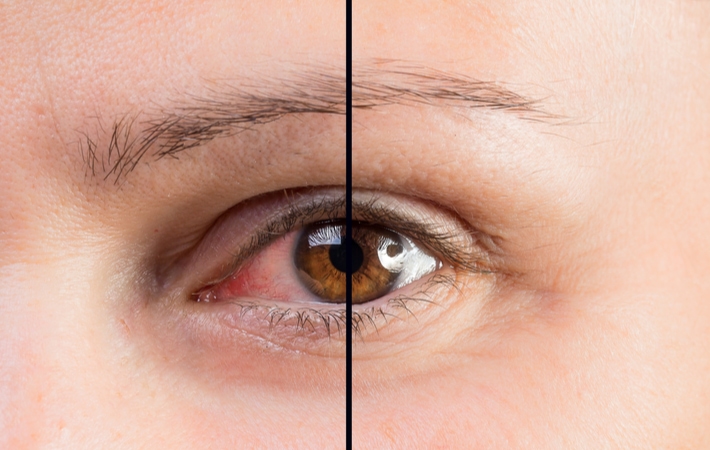Whether you wear corrective eyewear or not, blurry vision can occur at any time. While blurry vision doesn’t always warrant panic, some causes are more serious than others.
Your eye focuses light to create the images you see. When your eye cannot focus properly, the result may be blurry vision. But the eye has over 2 million working parts, so the reasons for blurry vision are numerous, including dry eye, cataracts, and other eye diseases. Let’s discuss several common reasons your vision might be blurred.
Getting to the root of your blurry vision requires a comprehensive eye exam with your optometrist. Annual eye exams help prevent the onset of eye conditions that can affect how clearly you see. If your vision seems blurry, book an appointment to find out why.
Chemical Injuries
Exposure to chemicals can cause your vision to go blurry. A chemical eye injury includes direct physical contact (like a liquid in the eye). But airborne chemical fumes can also burn your eyes. If you are using chemicals at home or work, be conscious of the risks to your vision and consider wearing protective glasses.
The signs of a chemical burn in your eye include:
- Pain
- Redness
- Irritation
- Inflammation
- Tearing
- Blurry vision
- Eyelid swelling
- Eyelid twitching
- A sensation of something in your eye
If you have experienced a chemical eye injury, flush your eye with clean, warm water for 20 minutes.
Chemical burns should be considered an eye emergency and managed by an eye doctor. Contact our office immediately for emergency eye care or go to your nearest hospital.
Detached Retina
Retinal detachment is a serious and sight-threatening issue. It happens when the retina, a sensitive light-capturing layer at the back of your eye, is damaged. This can happen when the retina is starved of oxygen or when a tear forms in the retina allowing fluid to wedge between the retina and the network of veins underneath.
Blurry vision can be accompanied by a grey, swirling curtain of floaters descending over your vision. You might also notice flashing lights preceding this type of vision loss.
Retinal detachment can be caused by all of the following:
- Eye injury
- Blow to the head
- Eye diseases
- Eye surgery
- Diabetes
- Excessive myopia
It can stem from several root causes, but the result is the same: total or partial blindness without direct medical intervention. It’s an eye emergency without a doubt, so contact us immediately when blurry vision, swirling veils over your vision, and flashes out of nowhere occur together.
Autoimmune Disorders
Your iris is the coloured web that covers your pupil, letting light through to the ocular lens behind it. Iritis refers to an autoimmune reaction (or infection) of the iris. Iritis manifests with symptoms like blurry vision and sensitivity to light.
While iritis can occur by itself it also appears with another autoimmune disorder called rheumatoid arthritis.
Rheumatoid Arthritis & Sjogren’s Syndrome
Rheumatoid arthritis itself often appears alongside Sjogren’s syndrome, another autoimmune disorder that attacks the moisture glands in your eyes and mouth, causing them to struggle with normal function.
This attack on moisture glands can lead to dry eye syndrome, which might also affect the outer vision-focusing surface, called the cornea. Some patients with dry eye symptoms trace the cause back to autoimmune disorders.
You can help control blurry vision with dry eye therapy. Annual eye exams manage your ocular health and identify when autoimmune disorders are affecting your vision.

Dry Eye Syndrome
Whether the result of rheumatoid arthritis or a long list of other causes, dry eye syndrome itself can lead to blurry vision. Other symptoms of dry eye include:
- Discomfort and irritation
- Red eyes
- Light sensitivity
- Tired eyes
- Feeling as if there is a foreign body in your eyes
- Itching
- Watery eyes
Dry eye is the product of an imbalance in your tear film, which itself can be built upon many possible underlying causes. Dry eye therapy is a multipronged approach to restoring your tear film’s balance. Dry eye syndrome is not in itself a reason to panic, but when left untreated it can lead to more severe discomfort.
Book an appointment to discuss dry eye therapy with your optometrist and the treatments that can help you see more comfortably and clearly.
Digital Eye Strain
Your vision might be blurry if you are using digital screens throughout your day. Digital eye strain, or computer vision syndrome, is a condition that affects how our eyes perform and feel after extended computer use. The severity of digital eye strain depends on your lifestyle choices and working habits.
The symptoms of digital eye strain include:
- Blurred vision
- Headaches
- Eye irritation
- Double vision
- Excessive tearing
- Dry eyes
- Eye pain
Laptops, cell phones, and tablets emit blue light from their displays. This type of light is healthy at appropriate levels but can affect the way your eyes feel with today’s increasing digital demand. Using blue-light-blocking glasses can help relieve the effects of computer vision syndrome.
Check out our eyewear collection for glasses that can be fitted with blue-light-blocking lenses.
Eye Infections
If you have an eye infection, particularly a bacterial one, blurry vision may present itself as a symptom. Eye infections can take many forms, but a common infection is pink eye (conjunctivitis).
Pink eye and other infections are typically accompanied by a rough sensation of grit in your eyes and sensitivity to light. If you do have a bacterial eye infection, you’ll need a topical treatment or antibiotics to recover.
Your optometrist can identify your infection with an eye exam and recommend the best steps for healthy vision that isn’t blurry.
Cataracts
Cataracts cause clouding of the eye’s lens and can occur in one or both eyes. Cataracts occur naturally, develop gradually, and usually happen to people over 40.
Blurry or foggy vision is a sign of cataracts, especially if it comes and goes, or if it’s limited to only one of your eyes. Blurred vision can develop without pain or redness. Other difficulties include problems with night driving, halos around light sources, and refractive errors.
Cataracts that make clear vision very difficult are often treated with cataract surgery. Book an appointment if you suspect you have cataracts and your optometrist can discuss treatment solutions.
Age-Related Macular Degeneration
Perhaps one of the most important parts of your retina is the macula, the detail-detecting center of your eye. Abnormal blood vessels can grow there, causing blood or other fluid transfer that can interfere with your macular cells. This typically happens to people over the age of 50 and can lead to macular degeneration.
Wet Age-Related Macular Degeneration
Along with blurriness, wet age-related macular degeneration (AMD) can come with other, quickly progressing, and sight-threatening symptoms. You might notice dark spots, hazy vision, and localized blurry spots in your field of vision. It tends to worsen quickly and noticeably.
Dry Age-Related Macular Degeneration
In dry AMD, blurriness is accompanied by a distortion of straight lines in your vision, difficulty seeing in low light, and trouble recognizing faces. It moves more slowly than wet AMD, so the symptoms can seem less obvious.
Treatment of wet AMD can require drastic measures and quick thinking on the part of your eye doctor, so please don’t delay reporting your symptoms. Annual eye exams allow your optometrist to manage the earliest progression of AMD and build a game plan to help you manage it.
Refractive Errors
If you’ve noticed your vision slowly becoming blurrier over time, there might not be cause for concern. It could simply mean that your eyes and your prescription have changed. Blurry vision can result from a problem with how your ocular system focuses light into the back of your eye.
Focusing problems are classified as refractive errors. This includes common conditions like nearsightedness, farsightedness, and astigmatism. Blurred vision is the primary symptom of these errors.
Many refractive errors can be resolved with corrective eyewear like glasses or contact lenses. Annual eye exams allow your optometrist to evaluate your eyesight and make adjustments to your prescription to avoid blurry vision.
Treat Your Blurry Vision Today
The cause of your blurry vision can stem from many different eye conditions. The important thing is identifying blurred vision early and getting professional assessment as soon as possible. Some issues like dry eye and digital eye strain can be managed with help from your optometrist. Other causes of blurry vision, like glaucoma, need immediate emergency eye care. There is one universal truth when it comes to blurry vision — annual eye exams help keep you seeing clearly. Whether to prevent the progression of eye diseases or to sharpen up your prescription, exams help you understand the cause of your blurry vision.


